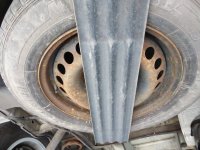Hi Guys,
Read this thread the other day and based on cars I have had in the past with the same issue, I decided to try to take the wheels off the van to-day.
It's not quite a year old yet, but I am sure it had been stood wherever for a few months before I bought it so I reckoned the wheels had not been off since manufacture.
All 4 wheels were well stuck on, rears more so for some reason and it took me ages to break the 'seal'.
The method I used to get them off, and this is probably controversial but has always worked for me in the past, is by using a 2m long piece of 4x2 laid on the actual alloy rim, not on the tyre. I then used a sledgehammer on the other end of the 4x2, very, very carefully, one knock at a time until the wheel loosens. Obviously keep the wheel nuts a few turns in place so the wheel does not fly off. I have always found the alloy rim to be best as the rubber tyre absorbs the impact of the blow and is not very effective. All alloys are fine, no damage done and I then sanded off the rust with wet and dry on the hub face and back of wheel and especially around the spigot as above photo. I then applied plenty of coppa slip to the mating faces and spigots, but as above, not on the wheel bolts.
Torqued to 180nM and jobs done.
Just think its worth reminding owners, and whatever method you prefer, if you have not had your wheels off, to check them yourselves or have it done professionally as there is not a cat in hells chance of doing this at the roadside/middle of night in the pouring rain or in some far away campsite!
Also, a reminder of the absolutely hopeless tool kit that comes as standard as I can see no way you would undo the wheel bolts using the standard pressed steel wrench.
A great idea detailed above about upgrading which I have done with a Britool 19mm 6 face socket and breaker bar.
Hope this helps.
Cheers.
Barry.















